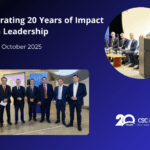Introduction to Practical Sustainability Strategies
I’m proud to share the release of the 3rd Edition of the global bestseller Practical Sustainability Strategies: How to Excel in ESG and Gain a Competitive Advantage (Wiley, 2025). Over a decade after its first release, this book continues to inspire professionals, executives, and students seeking to turn sustainability into measurable business success.
When George P. Nassos and I first published the book, our goal was simple: to prove that sustainability is not a financial burden but a powerful source of innovation and competitiveness. Today, with ESG shaping every major corporate decision, the book’s insights are more relevant than ever.
A Journey Through Three Editions
First Edition (2013)
The original edition quickly reached the U.S. Business Bestseller lists within four weeks and became one of the first sustainability books adopted in business school curricula across the U.S. and Canada—including DePaul University, the University of Illinois Chicago, and the University of San Francisco.
Second Edition (2020)
With a growing global audience, the second edition introduced teaching materials, slides, case studies, and assignments, helping universities in the U.S., Europe, and Asia integrate sustainability into their academic frameworks. Over 5,000 copies were used exclusively in graduate programs.
Third Edition (2025)
Published by Wiley in response to international demand, the new edition emphasizes ESG integration, climate legislation, circular economy, and corporate resilience. It includes fresh case studies and metrics to help companies turn sustainability challenges into long-term opportunities.
Benefits of Practical Sustainability Strategies
The book has been recognized globally because it combines academic depth with real-world application. Readers gain:
-
A clear roadmap to integrate sustainability into business strategy.
-
Tools and metrics to measure carbon, water, and social impact.
-
Case studies showing how leading companies transformed challenges into innovation.
-
Frameworks like GRI, ISO 26000, and The Natural Step to ensure transparency and credibility.
In other words, it goes beyond theory—it equips readers with practical skills to act, measure, and lead.
Practical Steps and Frameworks for ESG Excellence
Professionals can apply the book’s frameworks to improve ESG performance and corporate resilience. Some of the key strategies include:
-
Systems Thinking: Seeing the business as part of a broader social-ecological system.
-
Biomimicry: Learning from nature to design efficient, regenerative products.
-
Servitization: Shifting from selling products to delivering sustainable services.
-
Base of the Pyramid (BoP) Models: Innovating for underserved markets.
-
Circular Economy Integration: Designing for reuse, recycling, and long-term value creation.
Example: Common Mistakes to Avoid
Many organizations still treat sustainability as a marketing exercise rather than a strategic transformation. The book warns against this short-term view, emphasizing governance, accountability, and measurable results as the foundation for credibility.
A Message from the Author
As the Founder of the Center for Sustainability & Excellence (CSE), I’m deeply honored that this work continues to inspire professionals and academics worldwide. With ESG now at the core of competitiveness, Practical Sustainability Strategies remains a trusted guide for those who aim to drive real impact—from the classroom to the boardroom.
Watch the Testimonial Video
🎥 Hear what Michael Sheridan – Associate professor in Sustainability at SUNY New Paltz say about Practical Sustainability Strategies (3rd Edition)
FAQs
What is Practical Sustainability Strategies about?
It’s a comprehensive guide that helps organizations turn sustainability into a source of innovation, efficiency, and competitive advantage.
Is the 3rd Edition different from earlier versions?
Yes. The 2025 edition focuses on ESG integration, circular economy, and climate resilience—reflecting the latest sustainability trends.
Who should read it?
Executives, sustainability professionals, consultants, and academics who want actionable frameworks to lead ESG transformation.









